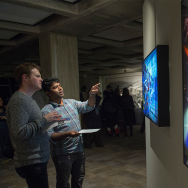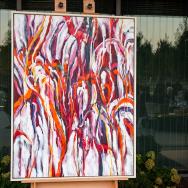The University of Chicago has announced the winners of its inaugural “Science as Art” contest, which highlights images of innovative scientific research from the microscopes, computer simulations and X-rays of the UChicago community.
From neurons to nanoparticles, the contest drew more than 100 entries from undergraduates, graduate students, staff, alumni, postdoctoral researchers and faculty members. Together, these images show the pursuit of knowledge in a new light, underscoring the beauty of intellectual exploration.
The grand-prize winner, chosen by a team of judges, is “Chondrules in Meteorites #5,” by UChicago alum Nicole Xike Nie, PhD’19.
Now a postdoctoral researcher at the Carnegie Institution for Science, Nie submitted the image from her research on the molecular makeup of meteorites, which can tell us what the conditions were like in the earliest days of our solar system.
The caption reads: “This photograph shows a thin section of a primitive meteorite called a chondrite. The various colors suggest different minerals that comprise the whole rock. The blue area in the center is what’s called a chondrule. It formed in space when a molten, millimeter-sized silicate droplet crystallized. Chondrules are among the oldest known materials in our solar system.”
The image was taken with a microscope using polarized light, but the color is not altered in any way.
The audience favorite, chosen by a March Madness-style bracket on UChicago’s social media channels, is:
“Magellan Telescopes & the Milky Way,” a photograph at the Magellan Telescopes taken by fourth-year astrophysics Ph.D. student Adina Feinstein.
Feinstein wrote: “This was the last time I was down observing at the Magellan Telescopes in Chile before the COVID-19 pandemic hit. On this run, I was observing several transiting planets, or planets crossing between us and their host star, with the goal of measuring their spin-orbit alignment. The spin-orbit alignment between a planet and its star can inform us on the planet's formation and migration history. I took this photo during a long exposure of one of my fainter targets of the night. In the picture, you're seeing one of the two 6.5-meter Magellan Telescopes on the left. The band of dark “clouds” and pink streaking up from the top of the telescope is the center of our very own Milky Way galaxy.”
Two entries also received honorable mentions:
“A Large Share,” submitted by undergraduates Rowen Glusman and Isaiah Escapa and project manager Lauren Boegen. The image depicts Mary Calvert, an astronomer at Yerkes Observatory in the 20th century; her photo is overlaid on a plate from E. E. Barnard's Atlas of Selected Regions of the Milky Way which contains her handwriting. The submitters wrote, “According to Edwin Frost, Calvert was responsible for "a large share" of the editorial duties for the Atlas.” The plate features in an upcoming publication from their group.
“Edge of Awareness,” submitted by undergraduate researcher Kaylie Scorza. It is a microscope image of crystals taken after Scorza dried out a liquid used for cultivating and studying human gut bacteria.
In the caption, Scorza noted: “Polarizing filters were added to the microscope and adjusted to obtain the blue and white colors that give this image an otherworldly, harmonic quality. The absence of texture past the right edge of the formation adds intrigue—what do you think lies beyond this field of view?”
View the full, stunning set of entries at the Flickr gallery.
Winners and entries will be displayed around campus in the coming year.

